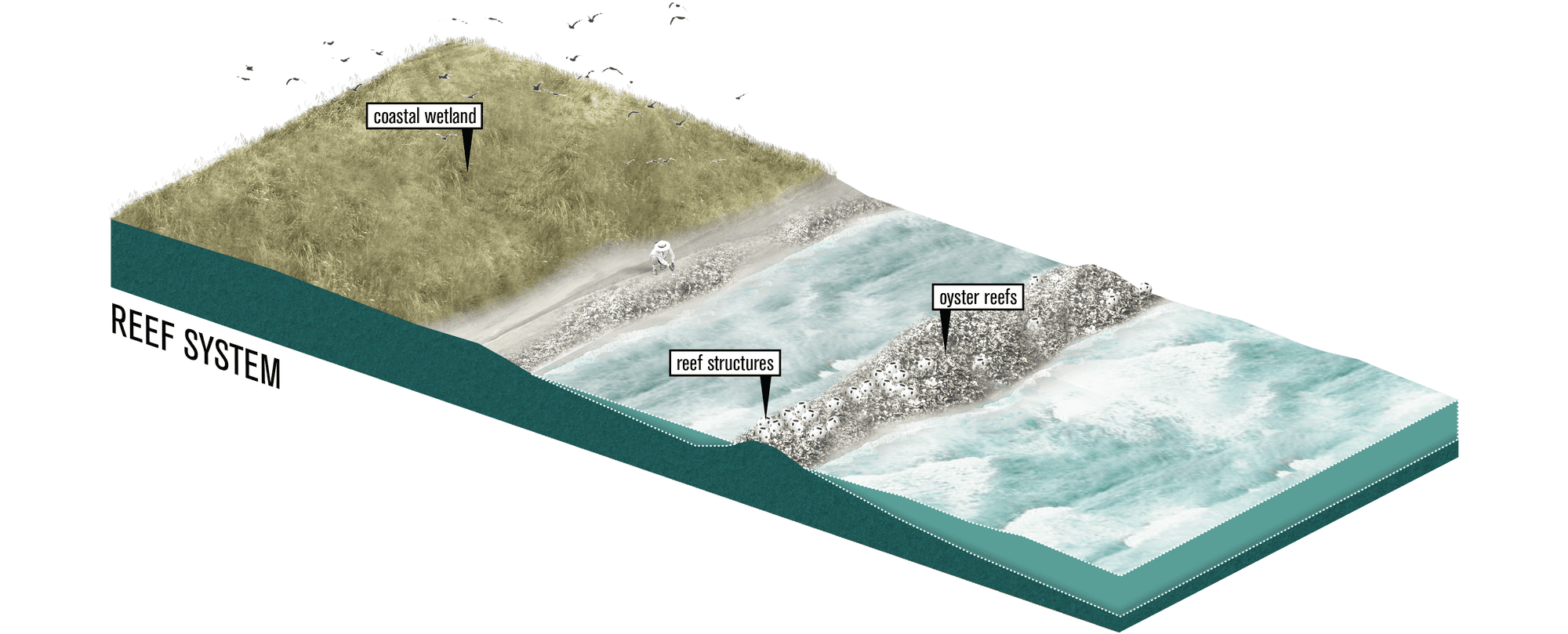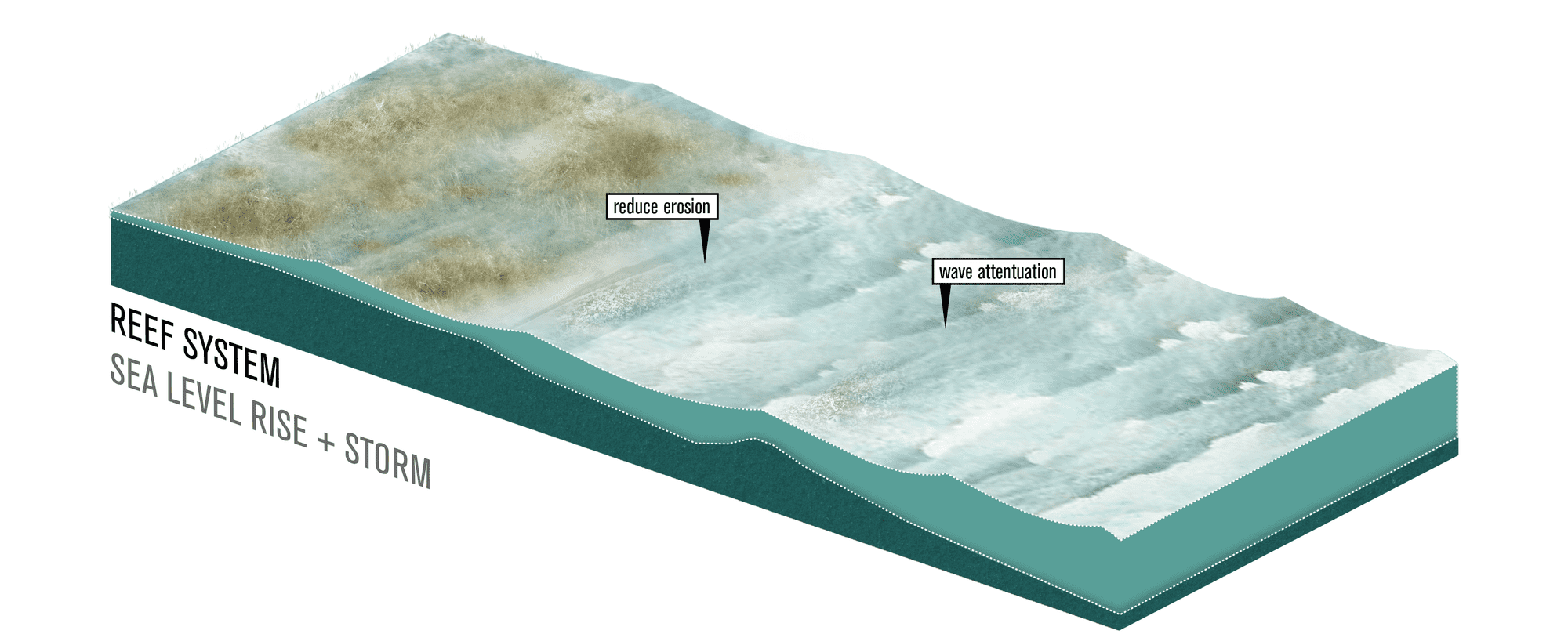Adaptation Strategy: Reef Systems
Reefs are under and near water ecosystems that provide protection against flooding and erosion. There are different types of reefs, however, they all share similar ecosystem functions. For example, oyster reefs are a vital resource for supporting offshore pelagic fisheries and the fishing industry. Coral reefs are also crucial for the protection and stabilization of coastal geomorphological conditions.1 In terms of shoreline protection, reefs help stabilize bottom sediments, reduce wave energy, and prevent erosion. They are also important for the fortification of the world’s coastal wetlands such as the ones in the Gulf Coast.2 Recently, research has focused on how reef systems could be incorporated into the construction methods of other flood protection structures such as breakwaters and seawalls.
How it works
Types of reef systems
- Fringing reefs grow around islands and continents near coastlines. They have submerged planforms of live corals that extend from the shore seawards just under the surface of the water. Fringing reefs comprise two components a reef flat and a reef slope. Fringing reefs are the most common type of coral reef system.
- Barrier reefs occur parallel to coastlines and are separated by deeper, wider lagoons. The reef creates a barrier between the coastline and the open sea. Barrier reefs may sometimes consist of assemblages of smaller reefs separated by a narrow strip of water, e.g., the Great Barrier reef.
- Atolls are coral rings primarily located in the mid-ocean that create protected lagoons. Atolls are formed when coral grows on the side of an underwater volcano that terminates above the sea surface. The peak of the volcano erodes gradually and overtime is submerged below the sea surface. The reef may eventually re-emerge as a ring of island or islets. 11
Benefits
- Reduces erosive impacts of wave currents offshore and onshore
- Serve as important nurseries for the spawning and breeding of pelagic fisheries
- Has the highest level of biodiversity of any shallow-water marine ecosystem, e.g., coral reefs support greater than 800 hard species of coral and over 4000 fish species
- Decreases the effect of storm surges and king tides onshore due to wave attenuation
- Possess high recreational and economic value estimated at approximately $9.6 billion of the total benefit of coral reefs.12
Challenges
- Climate change, e.g., rising sea surface temperature reduces reef vitality and reef cover
- Loss of coral reef cover increases wave action and erosion onshore
- Erosion due to construction, mining and farming increases sedimentation of rivers and oceans and eventually coral reefs
- Pollution from industrial waste, sewage discharge, oil spills, and agrochemicals lead to eutrophication and algal growth in coral reefs.
- Rising sea surface temperatures and acidification slows reef growth and reduces reef resilience 12 13
Example projects
Chesapeake Bay Oyster Recovery Program
Maryland VA, USA
Since the 1800’s oyster population in the Chesapeake Bay have been declining to a point where recent oyster population levels and biomass are less than 1 percent of historic levels.3 The decline has been attributed to overharvesting, diseases, and loss of habitat.4 The project began in 1996 and since then the U.S Army Corps of Engineers has been actively involved in implementing the Oyster Restoration Master Plan.5 The masterplan provides different scenarios in the restoration program which can range from a target of 14,400 – 35,000 acres of restored oyster reefs at an estimated cost between $1.56 – $6.50 billion.6 The masterplan serves as a foundation for working towards the restoration of oyster habitats and populations in 20 tributaries by 2025 which was established by the Chesapeake Bay Protection and Restoration Executive Order.7
Souris Offshore Reefs
Souris PE, Canada
In 2017, two artificial reefs were installed along the Souris causeway to protect it from the impacts of climate change and the effects of storm surges.8 Two reefs were constructed using local sandstone which cost a total of $115,000.9 The reef function in two ways: it reduces the impact of waves and deposits sediment landward of the reefs. The accretion of sediment allows builds up the beach profile and compensates for the loss of sediment caused by erosion. 14 Given its success, the Prince Edward Island government is considering expanding the project in other areas of the island as a response to the frequency of intense storm surges.10
Citations
-
1.
↑
Stokes, Shawn, et al. Restoring Gulf Oyster Reefs. June 2012, pp.5. http://www.mississippiriverdelta.org/files/2012/07/CGGC_Oyster-Reef-Restoration.pdf.
-
2.
↑
Ibid, 5.
-
3.
↑
“Chesapeake Bay Oyster Recovery Program.” Norfolk District, 22 Jan. 2019, https://www.nao.usace.army.mil/About/Projects/Oyster-Restoration/.
-
4.
↑
Ibid.
-
5.
↑
Ibid.
-
6.
↑
U.S. Army Corps of Engineers, and Baltimore and Norfolk Districts. Chesapeake Bay Oyster Recovery: Native Oyster Restoration Master Plan. Sept. 2012, pp. 6. https://www.nab.usace.army.mil/Portals/63/docs/Environmental/Oysters/CB_OysterMasterPlan_Oct2012_FINAL.pdf.
-
7.
↑
Ibid, 6.
-
8.
↑
“Souris Breakwaters Are Working with the Forces of Nature.” Wordmark of Government of Prince Edward Island, https://www.princeedwardisland.ca/en/news/souris-breakwaters-are-working-forces-nature.
-
9.
↑
Ibid.
-
10.
↑
Ibid.
-
11.
↑
National Geographic. (2020). Reef. https://www.nationalgeographic.org/encyclopedia/reef/
-
12.
↑
Scripps institution of oceanography. (nd). VALUE OF CORALS. https://sioweb.ucsd.edu/projects/coralreefsystems/about-coral-reefs/value-of-corals/
-
13.
↑
WWF. (2020). What are the main threats to coral reefs? https://wwf.panda.org/our_work/our_focus/oceans_practice/coasts/coral_reefs/
-
14.
↑
Living Shoreline, NC / Oyster Shell Sill https://www.publicradioeast.org/post/living-shorelines
-
i1.
↑
Oyster Reefs Planted Along Lafayette River. https://covabizmag.com/wp-content/uploads/2018/01/Low-tide-exposes-an-oyster-reef-on-the-Lafayette-River-Credit-Elizabeth-River-Project-Joe-Rieger-768x576.jpg.
-
i2.
↑
Intertidal Reefs Protect PEI Shoreline from Storm Surge. https://www.princeedwardisland.ca/sites/default/files/styles/news_node_featured_image/public/images/news/souris-breakwater-sized.gif?itok=D-Rkar_7.
-
i3.
↑
Figure 1. National Oceanic and Atmospheric Administration. (2019). Coral reef ecosystems. https://www.noaa.gov/education/resource-collections/marine-life/coral-reef-ecosystems

